Content
Published:
This is an archived release.
The numbers of prosecutions conditionally dropped in 2013-2015 were changed 1 June 2018. The changes mean that some of the figures in this article are not entirely in line with the latest official statistics in StatBank and the article that describes developments until 2015.
Fewer crime cases settled by the courts
In 2014, nearly 302 600 sanctions were registered, of which 32 600 were given in crime cases. A total of 19 650 sanctions were given by the courts, which is 10 per cent fewer than in 2013. In total, 269 600 persons were registered as sanctioned in 2014. Among these, 27 900 were sanctioned for one or more crimes, which is nearly 6 per cent less than the year before.
| 2014 | |
|---|---|
| All types of sanctions | 302 646 |
| All types of sanctions, on the spot fine not included | 77 762 |
| Sanctioned persons | 269 588 |
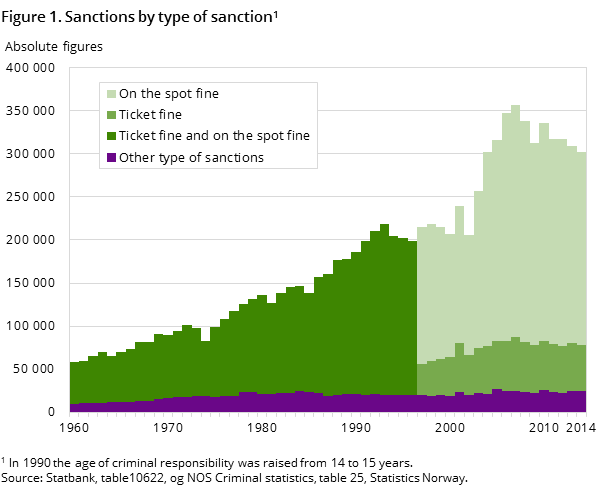
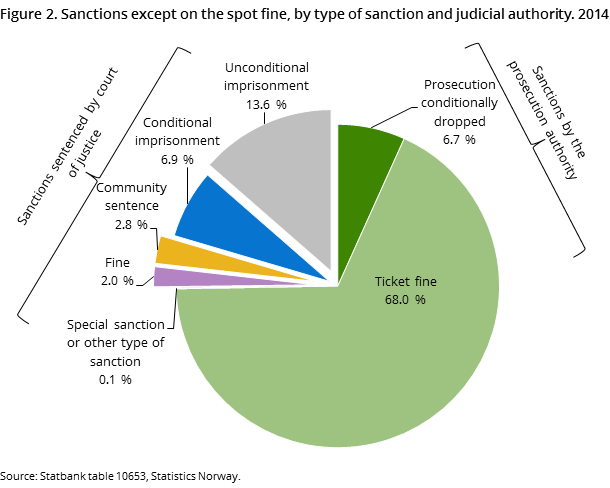
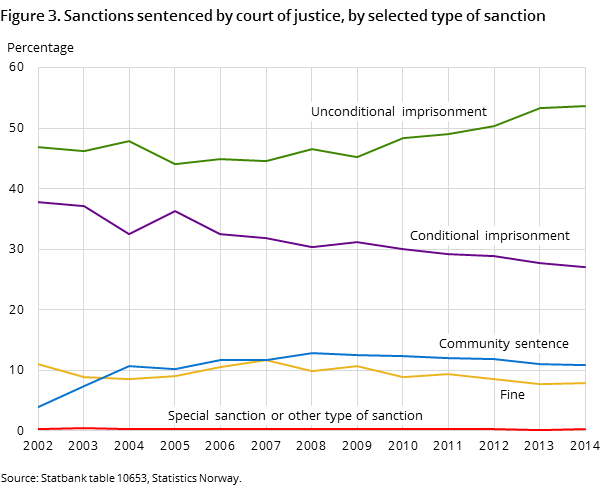
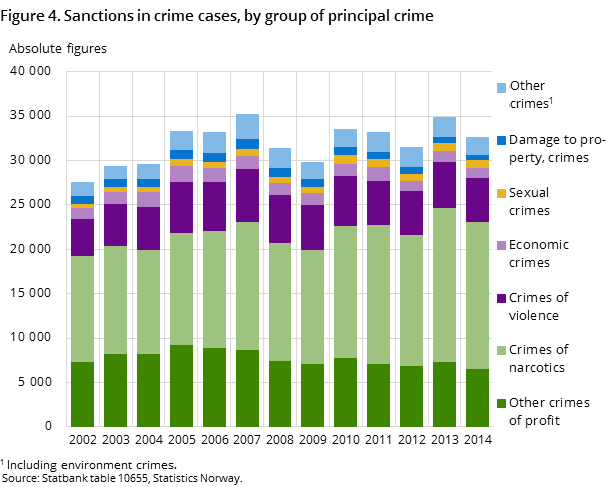
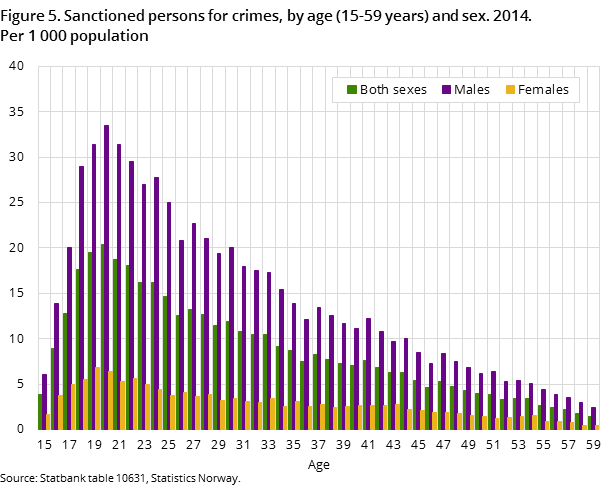
Of the 302 600 sanctions registered in 2014, 270 000 were given in cases with misdemeanours only and 32 600 were given in crime cases. In total, there were 6 700 fewer sanctions in 2014 than the year before, leading to an overall drop of 2.2 per cent.
Compared to the year before, 2014 saw a general decline for most categories in the statistics, which is evident in court levels, sanctions, offences and the age of persons sanctioned. Furthermore, the decline was most significant for crime cases and for sanctions given by the courts.
Three out of four sanctions are on the spot fines
As in previous years, the total scope of sanctions given in 2014 is dominated by the large number of on the spot fines, as shown in figure 1. Almost 224 900 on the spot fines were issued in 2014, making up 74 per cent of all sanctions. Among these, 92 per cent were given for traffic misdemeanours, predominantly speeding, while the remaining 8 per cent were given for less serious violations of the Customs Act.
Increase in charges conditionally dropped for misdemeanour cases
In contrast to the general decline in the total number of sanctions, charges conditionally dropped saw a further increase. In total, there were 5 250 incidents of charges being conditionally dropped in 2014, making a 61 per cent increase from the year before. This increase is primarily due to the prosecution authority issuing this type of sanction in over twice as many misdemeanour cases in 2014 than in 2013.
Fewer crime cases
The total number of sanctions given in crime cases saw a decline from just over 34 800 in 2013 to 32 600 in 2014 – a 6 per cent drop. Based on principal offence, there was a decrease in sanctions for all groups of crime, yet in absolute figures the biggest drops were seen for other offences for profit and narcotic offences.
The majority of crime cases settled by the prosecution authority
Far more sanctions are given by the prosecution authority than by the courts, as illustrated in figure 2. This is also the case for crime cases, where 59 per cent of all sanctions in 2014 were given by the prosecution authority, and nine out of ten were settled with a fine. Furthermore, 13 450 crime cases were settled by the courts, and more than nine out of ten were settled in a city and district court.
Most sanctions for drug crimes as the principal offence
Based on principal offence in 2014, 4.5 per cent fewer sanctions were given for narcotic offences than the year before. However, except from 2013, the 16 500 sanctions for narcotic offences as the principal offence in 2014 is more than in all previous years. For the first time, narcotic offences make up more than half of all crime cases.
Most drug cases settled by the prosecution authority
Of all sanctions with narcotics as the principal group of offence, about half were issued for violation of the Act relating to medicinal products. The prosecution authority settles as much as 91 per cent of these cases, which are often related to the use and possession of drugs. Eight out of ten cases were settled with a fine. The prosecution authority also settle most of the cases involving the more serious drug violations of the Penal Code, with nearly six out of ten resulting in a fine in 2014.
However, of the 702 sanctions in cases with serious crimes of narcotics as the principal offence in 2014, all were settled by the courts, and 86 per cent resulted in unconditional imprisonment.
Fewer cases settled by the courts
In 2014, 19 650 sanctions were settled by the courts. This is 10 per cent fewer than in 2013. Of all sanctions given by the courts, 54 per cent involved a sanction with unconditional imprisonment. The 10 550 unconditional imprisonment sentences in 2014 were nearly 10 per cent less than the year before. Compared to 2013, the percentage decrease was somewhat bigger for conditional imprisonment and community sentence, with 12 and 11 per cent respectively. The court’s allocation of the different types of sanctions was about level with 2013, after significant changes during the last couple of years, as shown in figure 3.
Unconditional imprisonment for about 70 per cent of murder cases
Of the 25 persons convicted for murder in 2014, 18 were sentenced to unconditional imprisonment. The average sentence was 5 050 days, which is about 14 years. The remaining 7 persons convicted of murder were given a special sanction. The allocation of these special sanctions was about the same in 2014 as in all previous years since the introduction of special sanctions in 2002. In the period 2002-2014, a total of 327 sanctions were given for murder, of which 238 were unconditional imprisonments, 59 were compulsory mental health care and 27 were preventive detention.
More persons given compulsory mental health care
The total number of special sanctions, as well as what types of special sanctions are given, varies from year to year. In 2014, a total of 42 special sanctions were registered; 14 were preventive detention, 27 were compulsory mental health care issued by the courts. The number of compulsory mental health care sentences is the most ever registered, however it is almost level with previous years.
In the period 2010-2014, a total of 108 sentences of compulsory mental health care were given, which is considerably more than the 62 given during the period 2002-2006. However, there does not seem to be a similar increase in the number of preventive detention sentences, which made up about half of all special sentences from 2002-2006, but fewer than 40 per cent in the period 2010-2014.
One out of ten given more than one sanction
Nearly 90 per cent of the total 269 600 sanctioned persons in 2014 were given only one sanction during the year, while 10 per cent were given two or more sanctions. This share has been stable over the last ten years.
Three out of four persons sanctioned are men
Of all persons sanctioned in 2014 with known sex, about 196 100 were men and 64 100 were women. The share of men among those sanctioned for crimes (84 per cent) is higher than the share of men among those given a sanction for misdemeanours (74 per cent). The gender distribution is somewhat unequally spread among the different groups of principal offence; the share of women sanctioned for offences was highest for traffic misdemeanours (26 per cent), other offences for profit (26 per cent) and narcotic offences (16 per cent).
Fewer persons sanctioned in nearly all age groups
Young persons have a clear over representation among those sanctioned for crimes, and as shown in figure 5 this is the case for both men and women. The share is highest among men aged 19-21 years, where just over 3 per cent were registered as sanctioned for one or more crime in 2014. Compared to the year before, there was a decrease in the number of persons charged in nearly all age groups, and this is evident both for those sanctioned for crimes and those given a sanction for a misdemeanour.
More under 18s sanctioned for misdemeanours
Unlike all other age groups, significantly more persons in the age group 15-17 years were sanctioned in 2014 than the year before. In total, the 4 300 sanctions given to the youngest offenders were 4 per cent more than in 2013, which is partly due to the 16 per cent more sanctions given in misdemeanour cases.
New types of sanctions for the youngest offenders
As the statistics on offences investigated also show, young offenders under 18 years of age have a different composition of offences than those charged and sanctioned in older age groups. The number of persons sanctioned in the age group 15-17 is also considerably smaller than in older age groups. However, from 2013 to 2014, there is a somewhat different development for this particular age group. This development must be seen in relation to the introduction of new types of juvenile sanctions (see text boxes at the foot of the article), as well as other changes from the previous 10 years. In 2014, a total of 1 650 charges were conditionally dropped, which is as much as 30 per cent more than the year before. Thus, this type of sanction made up 38 per cent of the sanctions given to those under 18 years of age. The increase in charges conditionally dropped for those under 18 years is thus a continuation of developments over time, with relatively extensive changes in the use of penal sanctions for 15-17 year olds.
Smaller share of the Oslo population sanctioned
After a significant increase in the previous year, 2014 saw fewer persons sanctioned for crimes among those residing in Oslo. Thus, Oslo is the county with the biggest decline in the number of persons sanctioned for crimes, but relative to the 2013 level and considering the population increase, there was an even bigger decline in Akershus (14 per cent) than in Oslo (12 per cent). However, in Finnmark there were more persons sanctioned for crimes in 2014 than the year before. Thus, Finnmark was the county that saw the highest share of persons sanctioned for crimes in 2014, with 8.9 per 1 000 population.
Most persons sanctioned reside in Norway
A total of 252 500 persons – about 95 per cent of all sanctioned persons with known residence – had a registered place of residence in Norway. In total, this means that about 6 per cent of the population aged 15 years or older were sanctioned for one or more offence. The corresponding share of the population sanctioned for crimes was about 0.6 per cent.
Fewer non-Norwegian citizens sanctioned for crimes
In 2014, nearly 82 per cent of all persons sanctioned had a Norwegian citizenship. The share of persons holding a Norwegian citizenship among those sanctioned for misdemeanours only was just over 82 per cent, while it was slightly smaller among those sanctioned for crimes, at 76.5 per cent.
Compared to the year before, there were nearly 6 per cent fewer non-Norwegian citizens sanctioned for crimes in 2014. However, the number of non-Norwegian citizens sanctioned for traffic misdemeanours in 2014 was 3.5 per cent more than the year before. This contributed to an overall increase in the number of non-Norwegian citizens sanctioned, both for misdemeanours and for the total number of sanctioned persons.
Of the 6 580 non-Norwegian citizens sanctioned for crimes, 4 300 were holding a citizenship from another European country, 1 200 from an African country and 860 from an Asian country. Compared to the decrease in the number of sanctioned Norwegian citizens (5.5 per cent), the decrease from 2013 was somewhat smaller for citizens of other European countries (2 per cent). However, the decrease in sanctioned citizens of African and Asian countries was considerably higher, with 12 and 9 per cent respectively.
Follow-up programme for juvenile offenders: new condition for sanctions with conditional imprisonment and charges conditionally droppedOpen and readClose
Following trial schemes in parts of the country, the follow-up programme for juvenile offenders was introduced as a penal sanction for juvenile offenders on 1 July 2014.
A juvenile follow-up programme may be decided by the prosecution authority as a condition to charges being conditionally dropped. From in-court criminal cases, such programmes may also be given as a condition to conditional imprisonment. As for juvenile sanctions (see next text box), follow-up programmes for juvenile offenders are coordinated by The Norwegian Mediation Service.
Conditions from conditional imprisonment and from cases where charges are conditionally dropped are not included as a part of Statistics Norway’s statistics on Sanctions. Thus, the scope of such follow-up programmes does not form part of these statistics.
Juvenile sanctionsOpen and readClose
As of 1 July 2014, juvenile sanctions were introduced as a type of sanction for offenders under 18 years of age. Juvenile sanctions can be sanctioned by the courts as an alternative to unconditional imprisonment for juvenile offenders charged with serious or recursive crimes. The court sets a time frame for the juvenile sanctions, while the content of the sanctions – such as measures and conditions – is worked out in a meeting coordinated by The Norwegian Mediation Service.
By the end of 2014, only 5 cases of juvenile sanctions were registered. In the statistics, these are places under “Special sanction or other type of sanction”. In tables with sentencing, juvenile sanctions is broken down into values for the number of days with conditional imprisonment.
Contact
-
Sigmund Book Mohn
E-mail: sigmund.mohn@ssb.no
tel.: (+47) 94 32 77 22
-
Reid Jone Stene
E-mail: reid.jone.stene@ssb.no
tel.: (+47) 99 02 22 01
